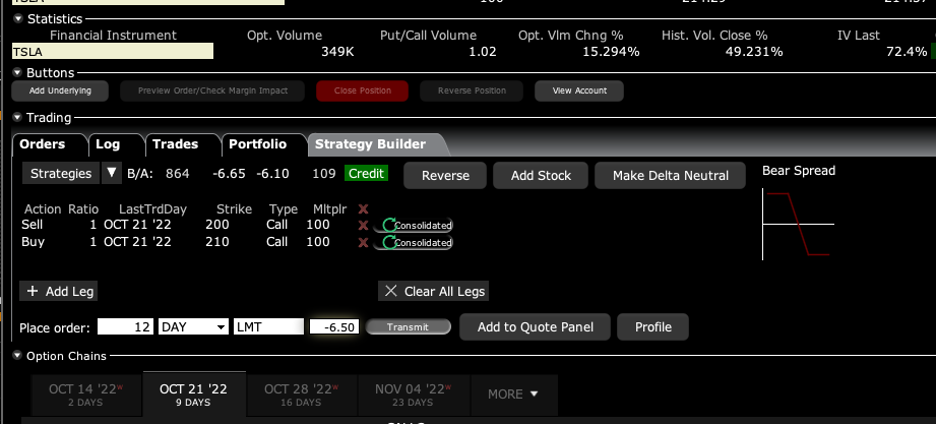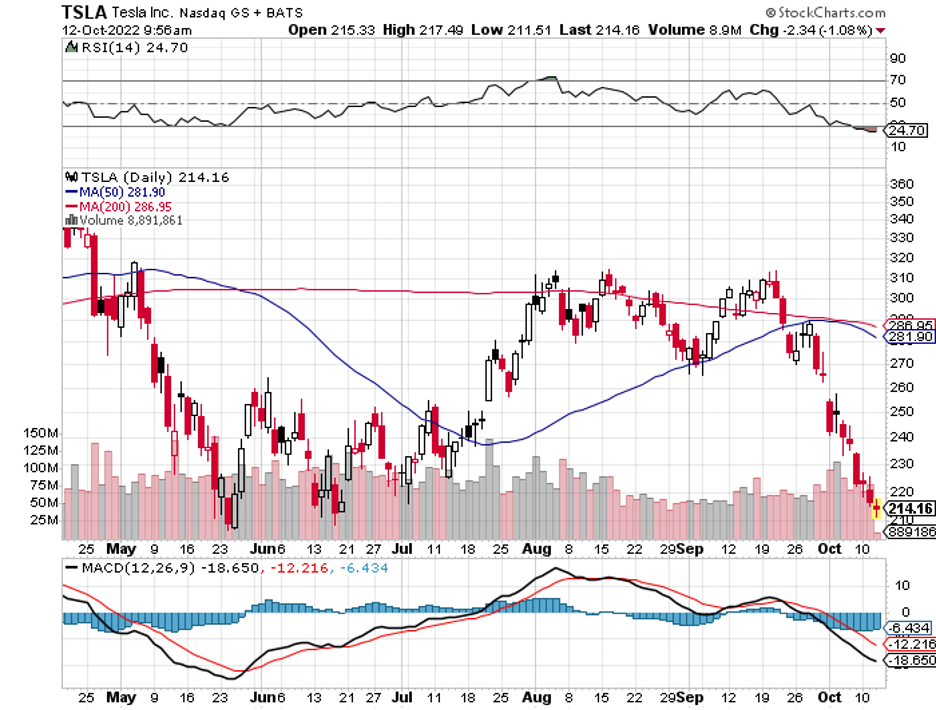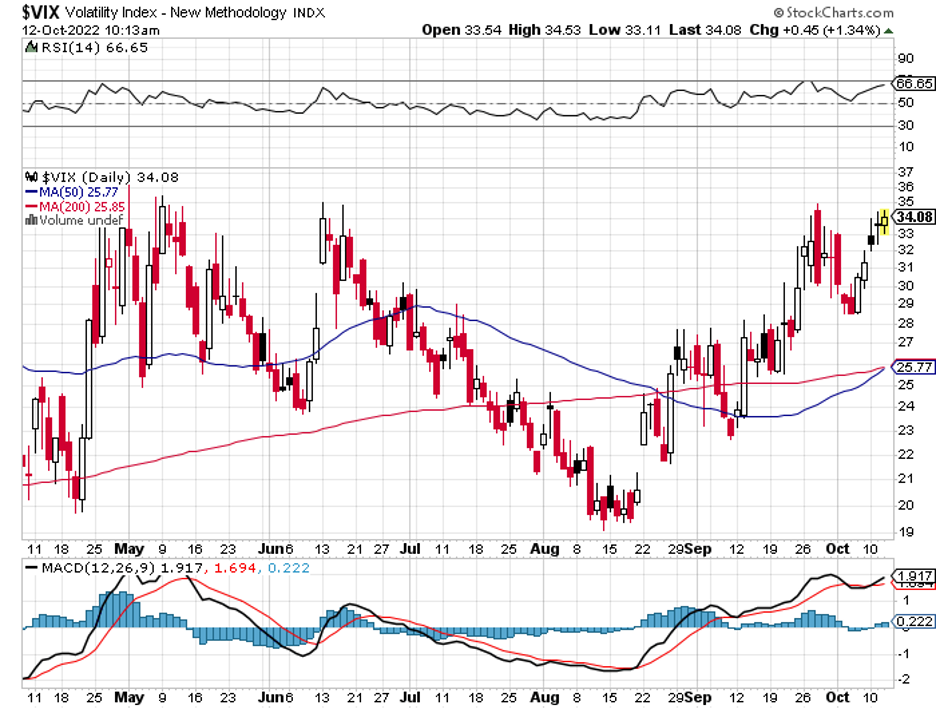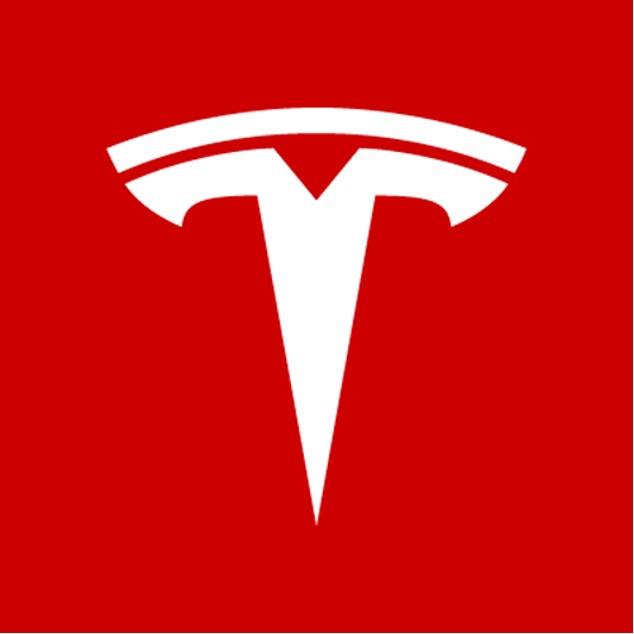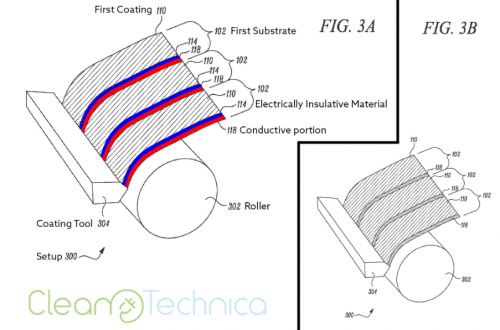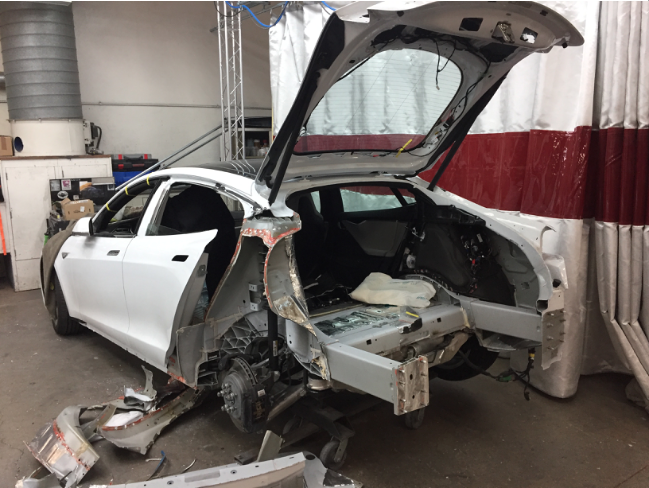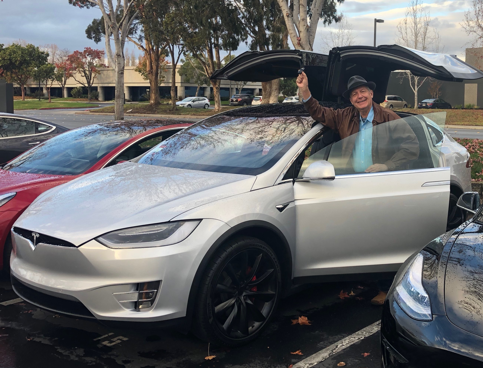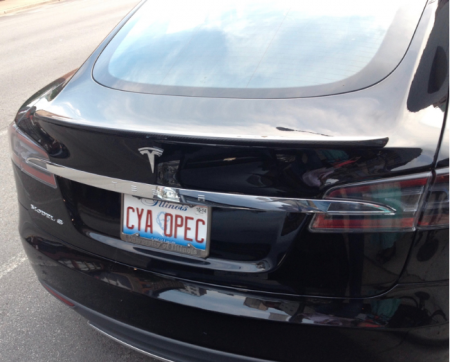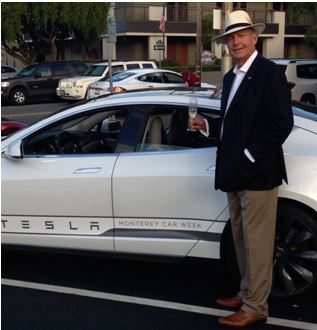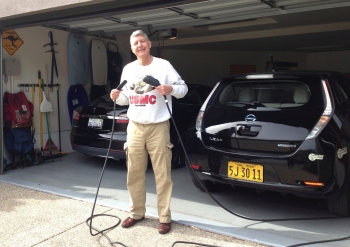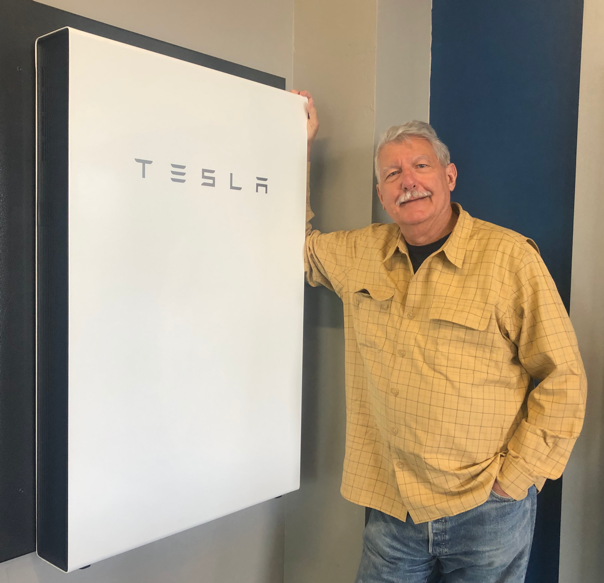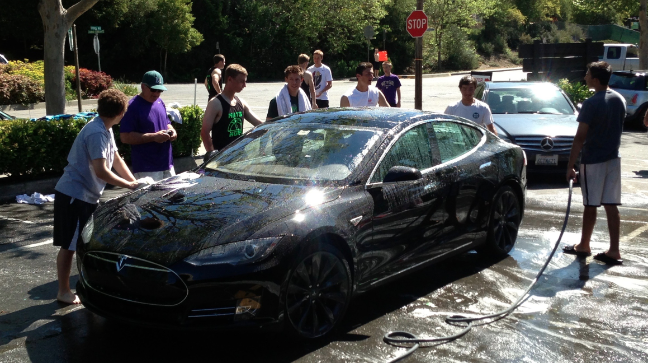When John identifies a strategic exit point, he will send you an alert with specific trade information as to what security to sell, when to sell it, and at what price. Most often, it will be to TAKE PROFITS, but, on rare occasions, it will be to exercise a STOP LOSS at a predetermined price to adhere to strict risk management discipline.

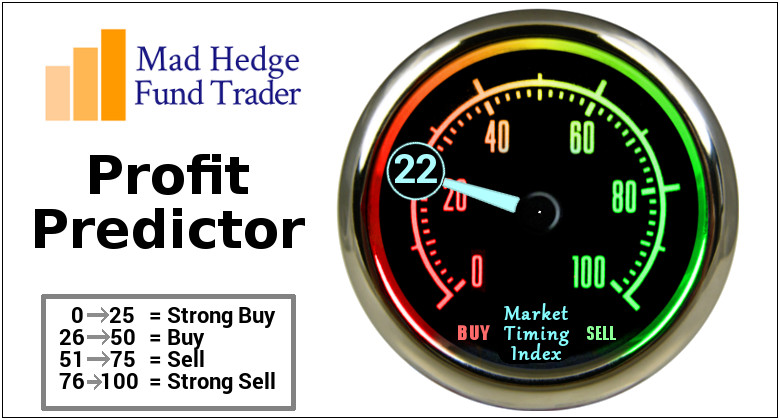
Trade Alert - (TSLA) – STOP LOSS
NOT FOR NEW SUBSCRIBERS
SELL the Tesla (TSLA) October 2022 $200-$210 in-the-money vertical Bull Call spread at $6.50 or best
Closing Trade
10-12-2022
expiration date: October 21, 2022
Portfolio weighting: 10%
Number of Contracts = 12 contracts
This trade alert represents a rolldown of the strike prices of our previous call spread in Tesla. With only six days until expiration, I need some extra cushion on the strike prices.
This will allow us to recoup the loss from this STOP LOSS. Another trade alert will follow shortly with lower strike prices. This rolldown is only possible because the Volatility Index (VIX) is at a sky-high $34.
I am therefore selling the Tesla (TSLA) October 2022 $200-$210 in-the-money vertical Bull Call spread at $6.50 or best.
Only use a limit order. DO NOT USE MARKET ORDERS UNDER ANY CIRCUMSTANCES. Just place a limit order and work it until you get done.
This was a bet that Tesla would not fall below $210 by the October 21 options expiration in 13 trading days.
Here are the specific trades you need to close out this position:
Sell 12 October 2022 (TSLA) $200 calls at……….........…....…$20.00
Buy to cover short 12 October 2022 (TSLA) $210 calls at……$13.50
Net Proceeds:……………………...........…….………..………….….....$6.50
Loss: $8.60 - $6.50 = $2.10
(12 X 100 X $2.10) = $2,520
If you are uncertain about how to execute an options spread, please watch my training video by clicking here.
The best execution can be had by placing your bid for the entire spread in the middle market and waiting for the market to come to you. The difference between the bid and the offer on these deep-in-the-money spread trades can be enormous.
Don’t execute the legs individually or you will end up losing much of your profit. Spread pricing can be very volatile on expiration months farther out.
Keep in mind that these are ballpark prices at best. After the alerts go out, prices can be all over the map.
A New Theory of Tesla, or Why I’m Raising My Target to $1,000
I’ve been battling shorts in Tesla for a decade….and you won.
Look at the price of Tesla shares today and I have to laugh. From the $2.35 I paid for the shares after its IPO bombed in 2010, the price is up more than 100 times. Back then, even Elon Musk gave the company only a 10% chance of surviving.
My first Tesla, chassis no 125, was scrapped for parts a long time ago, thanks to a drunk driver in a GM Silverado on Christmas Eve. A lot of people talk about Tesla, but few have completely taken them apart, as I have…. twice.
Yes, it’s still true that if you buy the stock, you get the car for free, possibly a fleet of them.
I set my target at $1,000 a decade ago. My assumption was that the company would take over a large part of the global car market, about 90 million vehicles a year, and 15 million in the US alone. Tesla’s own plans have it manufacturing about 20 million units a year by 2030.
Add in an eye-popping $15,000 upgrade for fully autonomous street-to-street driving, and Tesla should be making tons of money by then.
That looks on track to happen and is already reflected in the current share price. But what if there is more to Tesla? A lot more?
In fact, after making the rounds in Silicon Valley, it’s clear that Tesla is just getting started. Tesla will become the largest publicly listed company in the world, surpassing Apple, and account for an important share of US GDP.
It might even become the world’s first $10 trillion company.
Yes, it will even grow larger than Saudi Aramco, which manages the kingdom’s oil riches. The irony is rich.
Let’s say that it reaches its ambitious 2030 goal of 20 million units. Then what?
For a start, when Tesla goes solid-state, battery efficiencies will increase 20-fold, costs will drop by 95%, and vehicle ranges will double. This could happen in as soon as two years. They already have the solid-state batteries. All they need now is to understand economical mass production.
The company has already said it is dropping the price of its cars to $25,000 in three years, but much more is possible.
Converting the car bodies from aluminum to carbon fiber, which the wheel wells are made of now, will further cut costs, increase ranges, and improve safety. Carbon fiber is five times stronger than steel at one-tenth the weight.
To reach that goal, the total Tesla fleet will have grown from 1.5 million units today to 100 million by 2030 and account for one-third of all the cars on the road. Those cars are going to need one heck of a lot of electricity to run.
Step in Tesla.
The company already has 20,000 superchargers in the US and that figure is doubling every year. No place in the country today is more than 100 miles away from a supercharger.
A Tesla Model 3 with a 100W battery pack driving 20,000 miles a year costs $720 to power at current prices. The entire fleet would cost $54 billion a year to run at a national average price of 12 cents/kWh.
Ring the cash register for Tesla….again.
Let’s say that rather than paying for electricity at an external charger at some distant shopping mall, you’d rather get the power at home for free.
Enter Tesla.
Finally, after a decade of waiting, Solar City, a Tesla subsidiary, is manufacturing cost-competitive solar roof tiles, or photovoltaic tiles. I have several readers already installing them at this moment. With a 15-year head start in silicon and battery technology, there is no reason why Tesla shouldn’t dominate in this industry as it already has with cars.
To keep the calculations simple, if 75 million homeowners buy solar roofs at an average of $36,000 each, the gross sales would reach $2.7 trillion. Kaching! To get a quote for your new solar roof, please click here.
To get the most out of your solar roof, you really need to buy a couple of 13.5W Tesla Powerwall storage batteries which would cost $25,000 installed. That way, the solar tiles will charge the batteries during the day, which will then power your house at night. You will become grid independent forever, as I have been for years.
Where do Powerwalls come from? Not the stork. They are recycled batteries from old Tesla cars. You can recycle silicon. You can’t recycle CO2.
That will protect you from soaring electric power costs driven by coming cascading bankruptcies of public utilities around the country, all caused by global warming. You also have your own power supply for the ten days a year the grid is down from wildfires on the west coast, or hurricanes on the east coast.
When the neighborhood lights go out, I charge my neighbors a bottle of wine for a cell phone charge. It’s not a bad racket, but I’m getting more than I can drink. In fact, I am producing enough excess electricity to power my entire neighborhood, about 20 houses.
Under the current law, the federal government will pay for 30% of your cost with alternative energy tax credits.
Naturally, you are going to want highspeed WIFI so all of the elements of your integrated solar solution can talk to each other and upgrade whenever they want. So, you’re going to need a Tesla Starlink satellite connection. The system now in beta testing will eventually deliver a 500 megabyte a second WIFI connection anywhere in the world. Starlink is already running the Internet in Ukraine….for free.
The global WIFI market is expected to grow to $7.2 trillion by 2025 (click here for the link). Give half of that to Tesla and you get another $3.6 trillion in sales. Oh, and if you want to sign up as a beta tester for Starlink, please click here.
Did I mention that Musk also owns a rocket company, Space X, which can launch satellites into space at one-tenth the cost of all competitors? Elon’s goal is to cut costs 100-fold. Musk has already taken over a lot of launch business from Europe which used to go to Russia.
Looking at Elon’s big picture as an engineer and scientist, I am amazed to find so many 10X and 100X improvements going on all at the same time!
Add all this together and you might get a market capitalization for Tesla of $10 trillion. Elon Musk would become worth $2 trillion. Then he really can afford that trip to Mars.
This prompts me to raise my target for Tesla shares to $1,000.
That’s not a particularly bold prediction. It’s only 3.6X the current share price, compared to the 117X gain seen since the IPO.
Hey, I got the last 117X right, what’s another 3.6X?
Nobody ever accused me of thinking small.
And if Tesla really does become a $10 trillion company, you’d be right to raise antitrust concerns. But as anyone who has done the math on breaking up these big companies can tell you, such a move would double their value. Tesla at $2,000 a share, anyone?
And as incredible as it may seem, Elon Musk outlined all of his grand global vision to me personally in great detail when I first met him in 1999 pitching me for an investment in X.com, which later became PayPal (PYPL).
Then the bright-eyed, fresh-faced overconfident kid was only 27 and worth a mere $10 million. But he had a nice car, a million-dollar 618 hp McLaren F-1 with a V-12 engine.
A pittance really.
I passed, which is why I am still working today.
No kidding.
Tesla’s Solid State Batter Design
What its Modeled After
Chassis No. 125….R.I.P.
My Latest Set of Wheels
Like-Minded Found in Chicago
At the Pebble Beach Car Show
Going All-Electric
13.5 kWh Powerwall, Enough Juice to Run My House for a Day
This Lot of 300 Cars in Fremont Gets Filled and Emptied Out Three Times a Day
Back in 2010, the First Tesla They Had Ever Seen


